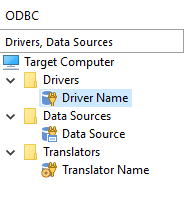
1. Understanding ODBC: A Comprehensive Guide

1. Understanding ODBC: A Comprehensive Guide
Table of Contents
- Introduction
- Registration
- Using Advanced Installer
- GUI
- Working with Projects
- Installer Project
* Product Information
* Resources
* Package Definition
* Requirements
* User Interface
* System Changes
* Server
* Internet Information Services Page”)
* ODBC
* Driver Properties
* Data Source Properties
* Import Data Source Dialog
* Translator Properties
* SQL Databases
* SharePoint Page
* Silverlight Page
* Custom Behavior - Patch Project
- Merge Module Project
- Updates Configuration Project
- Windows Store App Project
- Modification Package Project
- Optional Package Project
- Windows Mobile CAB Projects
- Visual Studio Extension Project
- Software Installer Wizards - Advanced Installer
- Visual Studio integration
- Alternative to AdminStudio/Wise
- Replace Wise
- Migrating from Visual Studio Installer
- Keyboard Shortcuts
- Shell Integration
- Command Line
- Advanced Installer PowerShell Automation Interfaces
- Features and Functionality
- Tutorials
- Samples
- How-tos
- FAQs
- Windows Installer
- Deployment Technologies
- IT Pro
- MSIX
- Video Tutorials
- Advanced Installer Blog
- Table of Contents
Disclaimer: This post includes affiliate links
If you click on a link and make a purchase, I may receive a commission at no extra cost to you.
ODBC page
There are three ODBC components you can add in this page: drivers, data sources and translators. The user interface is composed from the tree control on the left side where all the drivers, data source and translators from the project will be displayed and from the currently selected element’s properties which are displayed on the right side.
The information presented in this article can be applied in a similar fashion toODBC page from Merge Module Project .

Adding a driver
 Use the [Add Driver… ] toolbar button, the “Add Driver…” tree/list context menu item or press the + key while the tree control is focused.
Use the [Add Driver… ] toolbar button, the “Add Driver…” tree/list context menu item or press the + key while the tree control is focused.
When adding a driver, please make sure it corresponds with the server architecture it’s designed for (x86 or x64). The driver’s encoding must also be compatible with the server (UNICODE or ANSI).
Creating a new data source
 Use the [New Data Source ] toolbar button, the “New Data Source” tree context menu item or press the Insert key while the tree control is focused.
Use the [New Data Source ] toolbar button, the “New Data Source” tree context menu item or press the Insert key while the tree control is focused.
Importing an existing data source
 Use the [Data Source ] toolbar button or the “Import Data Source” tree context menu item. You can import DSN files directly or DSNs registered on your development machine, listed in the Import Data Source Dialog .
Use the [Data Source ] toolbar button or the “Import Data Source” tree context menu item. You can import DSN files directly or DSNs registered on your development machine, listed in the Import Data Source Dialog .
Only the data source’s name and attributes will be imported. You will need to set the ODBC driver yourself.
Adding a translator
 Use the [Add Translator… ] toolbar button, the “Add Translator…” tree context menu item or press the * key while the tree control is focused.
Use the [Add Translator… ] toolbar button, the “Add Translator…” tree context menu item or press the * key while the tree control is focused.
Locating the attached component for a driver, data source or translator
Use the “Go To Component” tree context menu item or press theF8 key while an element from the tree control is selected. This command will activate the Organization page with the appropriate component selected in the left tree control.
Setting the Current Feature
Advanced Installer will create components for the added resources as necessary. These components will be added to the Current Feature. Use the drop-down list box in the toolbar to change the Current Feature.
You can further manage the your package’s organization in the Organization page.
This feature is not available for Merge Module projects. For more details see the Merge Module Organization page.
Topics
- Driver Properties
Setting an ODBC Driver’s properties in Advanced Installer. - Data Source Properties
Setting an ODBC Data Source’s properties in Advanced Installer. - Import Data Source Dialog
Select ODBC Data Source’s from your machine that you want to include in the setup package. - Translator Properties
Setting an ODBC Translator’s properties in Advanced Installer.
Did you find this page useful?
Please give it a rating:
Thanks!
Report a problem on this page
Information is incorrect or missing
Information is unclear or confusing
Something else
Can you tell us what’s wrong?
Send message
Also read:
- [New] Camera Control Tips for Unshakable Images for 2024
- [New] Escalate Video Display in Public Profile for 2024
- Best Methods for Streaming PUBG Mobile Gameplay From PC or Mac
- Complete User Manual: Mastering the Art of Using ApowerShow
- Deep Dive Into Expert-Level Installer Programming Strategies
- Doxxing Explained: Essential Tips for Protection From Cybersecurity Expert, MalwareFox
- Expert Picks: The 10 Best Photo Retouching Software for Windows & macOS Users
- How to Modify Options in the ThinApp Setup Window for Optimal Performance
- In 2024, Harness the Potential of Gratuitous Timer Tools
- In 2024, How to Track WhatsApp Messages on Samsung Galaxy A05 Without Them Knowing? | Dr.fone
- In 2024, Riding the Wave of Solitary Podcast Popularity
- Leading Pimple Reduction Mobile Apps Reviewed: 2021 Edition
- Razer Mamba Driver Download: Swift and Simple Steps
- Resolving Persistent Crashes in World of Tanks Blitz: A Comprehensive Guide
- The Ultimate Guide to Purchasing Enigmatic Box Sets Online
- Title: 1. Understanding ODBC: A Comprehensive Guide
- Author: Michael
- Created at : 2024-10-05 05:24:15
- Updated at : 2024-10-11 05:00:20
- Link: https://fox-web3.techidaily.com/1-understanding-odbc-a-comprehensive-guide/
- License: This work is licensed under CC BY-NC-SA 4.0.